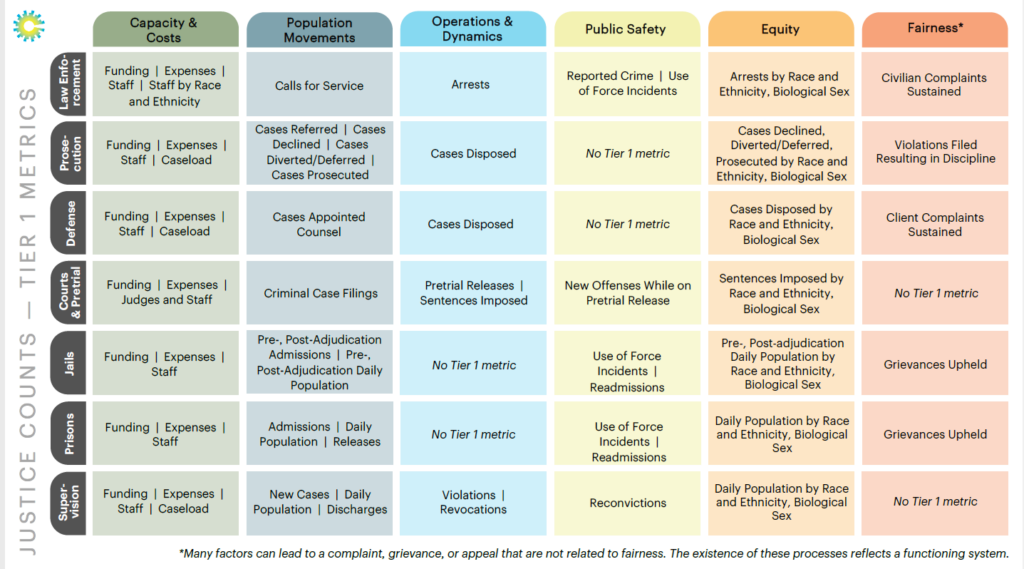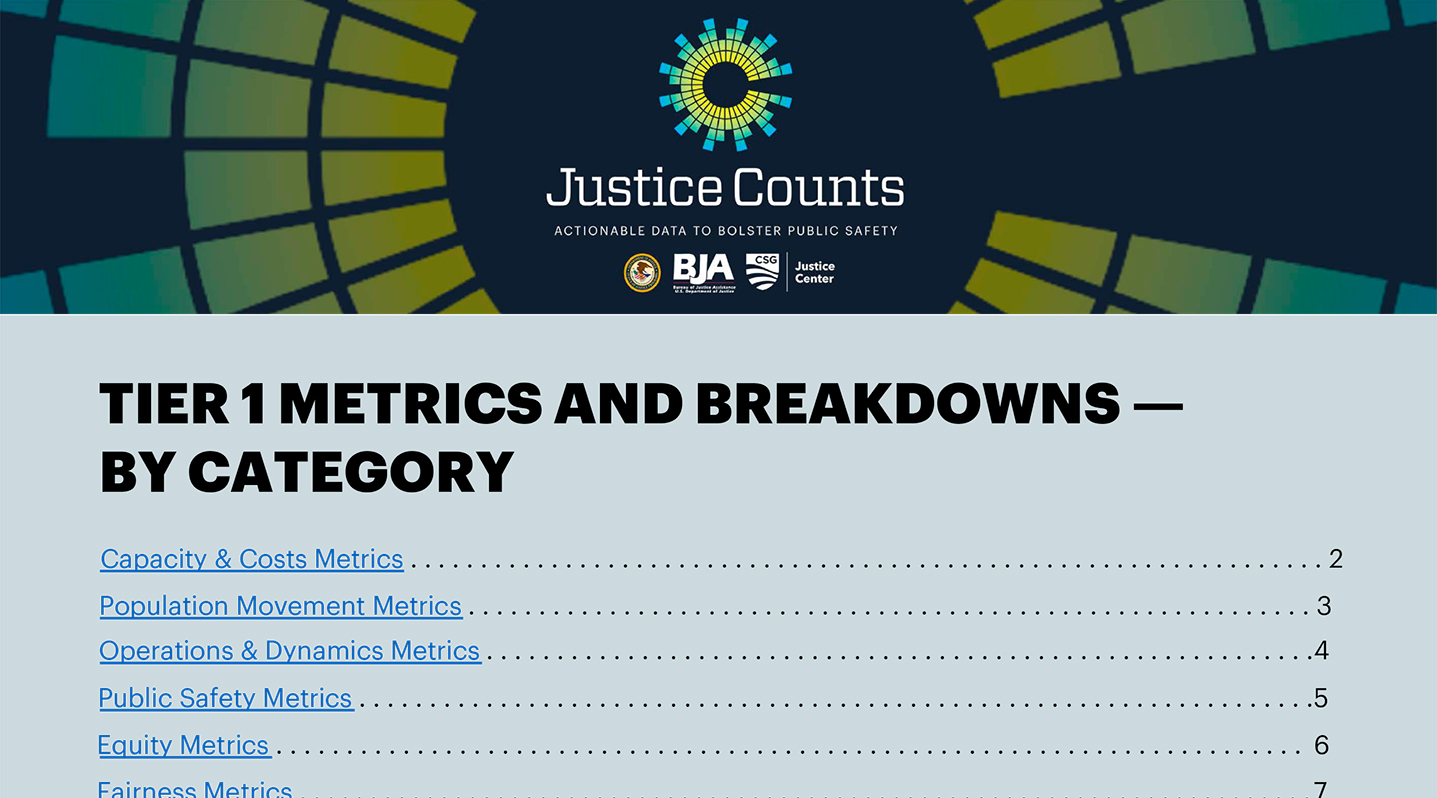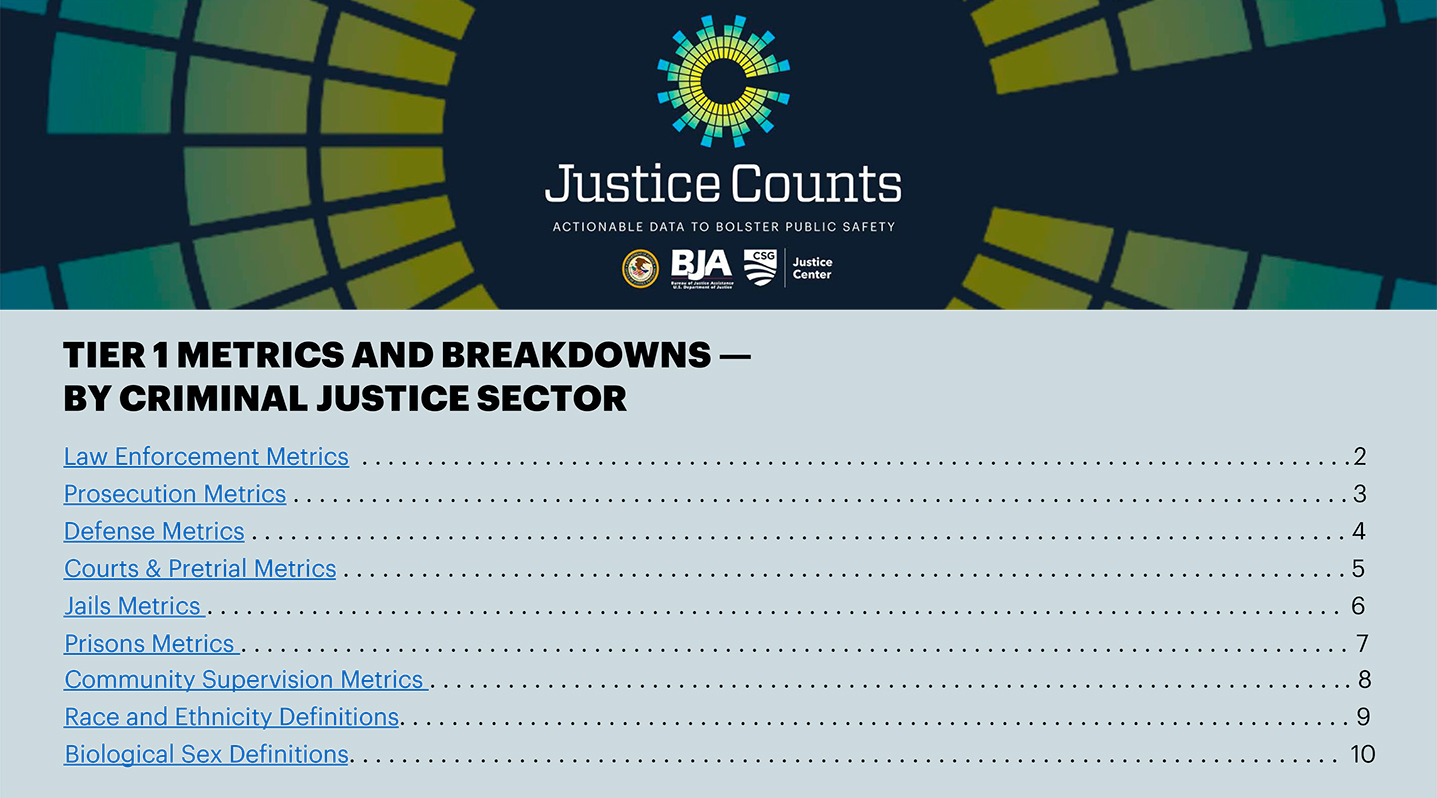Tier 1 Metrics
Tier 1 Metrics were released in May of 2022 and are being piloted by hundreds of criminal justice agencies across the country. These metrics are a powerhouse, structured across 7 sectors and 6 categories, offering both a panoramic view of essential measures and a comprehensive examination of each sector.
The Justice Counts initiative’s first undertaking was to create a list of metrics that could help criminal justice leaders tell their agencies’ stories and achieve long-term impact.
- Framework and Principles: We set the stage by creating a framework and operational principles.
- Extensive Literature Review: Embarking on an extensive literature review, we unearthed the key measures embraced in the field and identified those spotlighted in research and training literature as critical for operational and policy needs.
- Sector-Specific Subcommittees: We brought together leaders from every corner of the criminal justice world, forming subcommittees for law enforcement, defense, prosecution, courts and pretrial, jails, prisons, and community supervision.
- Metric Evaluation: These subcommittees combined their practical experience with insights from the literature, generating a staggering 1,148 potential metrics.
- Critical vs. Nice-to-Have: With razor-sharp discernment, the subcommittees then sorted these metrics into “critical” and “nice-to-have,” resulting in 593 critical and 555 nice-to-have metrics.
- Precision Refinement: Through rigorous rankings and spirited discussions, each subcommittee masterfully whittled down the list. The ultimate test of utility and feasibility distilled this list to the elite 86, known as Tier 1 Metrics.
- Public Debut: The subcommittees passed this elite list to the national steering committee and BJA for ratification, and with unanimous approval, these Tier 1 Metrics were released in May 2022.
Click any cell below for more information about these metrics and additional breakdowns.
| Sector |
Capacity & CostsDefinition: Capacity and Costs metrics measure the resources going into a sector and the expenditure of those resources. What it helps decision-makers and the public consider:
|
Population MovementsDefinition: Population Movement metrics measure entrances and exits from each sector of the system, the severity of behavior and response associated with those movements, and the length of stay in each sector. What it helps decision-makers and the public consider:
|
Operations & DynamicsDefinition: Operations and Dynamics metrics measure strategies and tactics that the criminal justice system uses to hold people accountable for negative behavior and to encourage positive behavior. What it helps decision-makers and the public consider:
|
Public SafetyDefinition: Public Safety metrics measure crime, victimization, and safety in communities and correctional settings. What it helps decision-makers and the public consider:
|
EquityDefinition: Equity metrics measure whether the criminal justice system treats people the same regardless of race, ethnicity, and gender What it helps decision-makers and the public consider:
|
Fairness*Definition: Fairness metrics measure how the criminal justice system meets its obligations and maintains legitimacy and trust. What it helps decision-makers and the public consider:
|
||||||||||||||||||||||||||||||||||||||||||||||||||||||||||||||||||||||||
|---|---|---|---|---|---|---|---|---|---|---|---|---|---|---|---|---|---|---|---|---|---|---|---|---|---|---|---|---|---|---|---|---|---|---|---|---|---|---|---|---|---|---|---|---|---|---|---|---|---|---|---|---|---|---|---|---|---|---|---|---|---|---|---|---|---|---|---|---|---|---|---|---|---|---|---|---|---|---|
Law EnforcementThough crime reduction and use of force are two important dimensions of policing, a complete understanding of the quality of law enforcement requires looking at all policing functions. In addition to protection and enforcement, police are also tasked with crime prevention, establishing community relationships, resolving disputes, and assisting individuals in need, among many other functions. Investments in law enforcement, including budget, recruitment, equipment, and training, along with department policies and community relations, also help shape the context in which police activity takes place. Therefore, efforts to measure police performance in a holistic way may wish to account for some of these less obvious but resource-intensive and necessary aspects of policing. |
Law Enforcement: Capacity & CostsFUNDING EXPENSES STAFF STAFF BY RACE AND ETHNICITY The categories and descriptions below are based on race and ethnicity definitions in U.S. Census Bureau – About the Topic of Race. For race and ethnicity metrics, the data shared should be categorized by the distinct combination of race and ethnicity as seen in the table below. It is possible that a single metric could have up to 24 unique racial and ethnic combinations. But, during onboarding, agencies will specify which of the combinations of race and ethnicity are available to be shared from their data systems.
STAFF BY BIOLOGICAL SEX Justice Counts currently uses biological sex (male, female, unknown) in lieu of gender identity. Justice Counts is working to determine the best way to account for gender identity through this initiative. More information is forthcoming. |
Law Enforcement: Population MovementsCALLS FOR SERVICE |
Law Enforcement: Operations & DynamicsARRESTS |
Law Enforcement: Public SafetyUSE OF FORCE INCIDENTS REPORTED CRIME |
Law Enforcement: EquityARRESTS BY RACE AND ETHNICITY The categories and descriptions below are based on race and ethnicity definitions in U.S. Census Bureau – About the Topic of Race. For race and ethnicity metrics, the data shared should be categorized by the distinct combination of race and ethnicity as seen in the table below. It is possible that a single metric could have up to 24 unique racial and ethnic combinations. But, during onboarding, agencies will specify which of the combinations of race and ethnicity are available to be shared from their data systems.
ARRESTS BY BIOLOGICAL SEX Justice Counts currently uses biological sex (male, female, unknown) in lieu of gender identity. Justice Counts is working to determine the best way to account for gender identity through this initiative. More information is forthcoming. |
Law Enforcement: FairnessCIVILIAN COMPLAINTS SUSTAINED |
||||||||||||||||||||||||||||||||||||||||||||||||||||||||||||||||||||||||
ProsecutionProsecutors can advance both public safety and equitable treatment under the law. The work of prosecutors has a significant impact on all parties in a case, from expert witnesses and people who have been victimized, to individuals charged. Prosecutors must be able to effectively balance the demands of each case with the needs of the court and the community and require proper resources to do so. |
Prosecution: Capacity & CostsFUNDING EXPENSES STAFF CASELOAD |
Prosecution: Population MovementsCASES REFERRED CASES DECLINED CASES DIVERTED/DEFERRED CASES PROSECUTED |
Prosecution: Operations & DynamicsCASES DISPOSED |
Prosecution: Public SafetyNo Tier 1 metric |
Prosecution: EquityCASES DECLINED, DIVERTED/DEFERRED, AND PROSECUTED BY RACE AND ETHNICITY The categories and descriptions below are based on race and ethnicity definitions in U.S. Census Bureau – About the Topic of Race. For race and ethnicity metrics, the data shared should be categorized by the distinct combination of race and ethnicity as seen in the table below. It is possible that a single metric could have up to 24 unique racial and ethnic combinations. But, during onboarding, agencies will specify which of the combinations of race and ethnicity are available to be shared from their data systems.
CASES DECLINED, DIVERTED/DEFERRED, AND PROSECUTED BY BIOLOGICAL SEX Justice Counts currently uses biological sex (male, female, unknown) in lieu of gender identity. Justice Counts is working to determine the best way to account for gender identity through this initiative. More information is forthcoming. |
Prosecution: FairnessVIOLATIONS FILED RESULTING IN DISCIPLINE |
||||||||||||||||||||||||||||||||||||||||||||||||||||||||||||||||||||||||
DefenseDefense counsel fulfills an important role in upholding the constitutional right to representation entitled to all Americans who are charged with a crime. This responsibility requires access to counsel who can provide representation, support services, and investigative resources. Effective representation requires appropriate resources and an understanding of the flow and timeline of cases through a jurisdiction and to defense providers. Measuring the caseload and capacity of defense is needed to inform policy and resource decisions. |
Defense: Capacity & CostsFUNDING EXPENSES STAFF CASELOAD |
Defense: Population MovementsCASES APPOINTED COUNSEL |
Defense: Operations & DynamicsCASES DISPOSED |
Defense: Public SafetyNo Tier 1 metric |
Defense: EquityCASES DISPOSED BY RACE AND ETHNICITY The categories and descriptions below are based on race and ethnicity definitions in U.S. Census Bureau – About the Topic of Race. For race and ethnicity metrics, the data shared should be categorized by the distinct combination of race and ethnicity as seen in the table below. It is possible that a single metric could have up to 24 unique racial and ethnic combinations. But, during onboarding, agencies will specify which of the combinations of race and ethnicity are available to be shared from their data systems.
CASES DISPOSED BY BIOLOGICAL SEX Justice Counts currently uses biological sex (male, female, unknown) in lieu of gender identity. Justice Counts is working to determine the best way to account for gender identity through this initiative. More information is forthcoming. |
Defense: FairnessCLIENT COMPLAINTS SUSTAINED |
||||||||||||||||||||||||||||||||||||||||||||||||||||||||||||||||||||||||
Courts & PretrialAt the county level, courts are the centralized authority on case processing and law enforcement. These institutions are tasked with handling and tracking all criminal charges filed against an individual, whether resolved by dismissal or acquittal or conviction by plea or trial. The secure and accurate processing of details related to these charges is necessary, as the courts are often also tasked with forwarding information about a case to other system actors. Courts must also manage critical data related to an individual’s prior criminal and release history for appropriate risk assessments and ensure fair access to justice. |
Courts & Pretrial: Capacity & CostsFUNDING EXPENSES JUDGES AND STAFF |
Courts & Pretrial: Population MovementsCRIMINAL CASE FILINGS |
Courts & Pretrial: Operations & DynamicsPRETRIAL RELEASES CASES DISPOSED SENTENCES IMPOSED |
Courts & Pretrial: Public SafetyNEW OFFENSES WHILE ON PRETRIAL RELEASE |
Courts & Pretrial: EquitySENTENCES IMPOSED BY RACE AND ETHNICITY The categories and descriptions below are based on race and ethnicity definitions in U.S. Census Bureau – About the Topic of Race. For race and ethnicity metrics, the data shared should be categorized by the distinct combination of race and ethnicity as seen in the table below. It is possible that a single metric could have up to 24 unique racial and ethnic combinations. But, during onboarding, agencies will specify which of the combinations of race and ethnicity are available to be shared from their data systems.
SENTENCES IMPOSED BY BIOLOGICAL SEX Justice Counts currently uses biological sex (male, female, unknown) in lieu of gender identity. Justice Counts is working to determine the best way to account for gender identity through this initiative. More information is forthcoming. |
Courts & Pretrial: FairnessNo Tier 1 metric |
||||||||||||||||||||||||||||||||||||||||||||||||||||||||||||||||||||||||
JailsJail populations include individuals who are awaiting trial, who have been convicted and are serving a short sentence, and who may be awaiting placement elsewhere. There are more than 3,000 jails in the United States, and it is difficult for decision-makers to find population statistics for their local jail with any regularity or accuracy. For decision-makers to ensure that jails are properly resourced for occupants and employees, it is necessary to understand the population and staffing dynamics as well as how effectively jails adhere to their policies and procedures. |
Jails: Capacity & CostsFUNDING EXPENSES STAFF |
Jails: Population MovementsPRE- and POST- ADJUDICATION ADMISSIONS (LISTED SEPARATELY) PRE- and POST- ADJUDICATION DAILY POPULATION (LISTED SEPARATELY) PRE- and POST-ADJUDICATION RELEASES (LISTED SEPARATELY) |
Jails: Operations & DynamicsNo Tier 1 metric |
Jails: Public SafetyNo breakdowns |
Jails: EquityPRE- and POST-ADJUDICATION (DAILY POPULATION BY RACE AND ETHNICITY (LISTED SEPARATELY) The categories and descriptions below are based on race and ethnicity definitions in U.S. Census Bureau – About the Topic of Race. For race and ethnicity metrics, the data shared should be categorized by the distinct combination of race and ethnicity as seen in the table below. It is possible that a single metric could have up to 24 unique racial and ethnic combinations. But, during onboarding, agencies will specify which of the combinations of race and ethnicity are available to be shared from their data systems.
PRE- and POST-ADJUDICATION DAILY POPULATION BY BIOLOGICAL SEX (LISTED SEPARATELY) Justice Counts currently uses biological sex (male, female, unknown) in lieu of gender identity. Justice Counts is working to determine the best way to account for gender identity through this initiative. More information is forthcoming. |
Jails: FairnessGRIEVANCES UPHELD |
||||||||||||||||||||||||||||||||||||||||||||||||||||||||||||||||||||||||
PrisonsPeople who are incarcerated in a state correctional facility need access to programming, health care, and appropriate measures to ensure safety. Transparency in prison data may include information related to the capacity of institutions, sentencing practices and guidelines set forth by the state, and the availability and quality of rehabilitative resources for people in custody. Most people in state custody will eventually return to their communities. Therefore, tracking effective reentry services and resulting recidivism rates for these individuals will improve decision-making for agency leaders, service providers, and policymakers. |
Prisons: Capacity & CostsFUNDING EXPENSES STAFF |
Prisons: Population MovementsADMISSIONS DAILY POPULATION RELEASES |
Prisons: Operations & DynamicsNo Tier 1 metric |
Prisons: Public SafetyUSE OF FORCE INCIDENTS READMISSIONS |
Prisons: EquityDAILY POPULATION BY RACE AND ETHNICITY The categories and descriptions below are based on race and ethnicity definitions in U.S. Census Bureau – About the Topic of Race. For race and ethnicity metrics, the data shared should be categorized by the distinct combination of race and ethnicity as seen in the table below. It is possible that a single metric could have up to 24 unique racial and ethnic combinations. But, during onboarding, agencies will specify which of the combinations of race and ethnicity are available to be shared from their data systems.
DAILY POPULATION BY BIOLOGICAL SEX Justice Counts currently uses biological sex (male, female, unknown) in lieu of gender identity. Justice Counts is working to determine the best way to account for gender identity through this initiative. More information is forthcoming. |
Prisons: FairnessGRIEVANCES UPHELD |
||||||||||||||||||||||||||||||||||||||||||||||||||||||||||||||||||||||||
SupervisionCommunity supervision usually encompasses probation and parole and is overseen by state and local governments or court jurisdictions. People serving on community supervision are subject to any number of standard and special conditions. To improve decision-making, data efforts may focus on felony and misdemeanor placements to parole and probation, caseload management, reasons for revocation, and staffing allocations for managing people on supervision. |
Supervision: Capacity & CostsFUNDING EXPENSES STAFF CASELOAD |
Supervision: Population MovementsNEW CASES DAILY POPULATION DISCHARGES |
Supervision: Operations & DynamicsVIOLATIONS REVOCATIONS |
Supervision: Public SafetyRECONVICTIONS |
Supervision: EquityDAILY POPULATION BY RACE AND ETHNICITY The categories and descriptions below are based on race and ethnicity definitions in U.S. Census Bureau – About the Topic of Race. For race and ethnicity metrics, the data shared should be categorized by the distinct combination of race and ethnicity as seen in the table below. It is possible that a single metric could have up to 24 unique racial and ethnic combinations. But, during onboarding, agencies will specify which of the combinations of race and ethnicity are available to be shared from their data systems.
DAILY POPULATION BY BIOLOGICAL SEX Justice Counts currently uses biological sex (male, female, unknown) in lieu of gender identity. Justice Counts is working to determine the best way to account for gender identity through this initiative. More information is forthcoming. |
Supervision: FairnessNo Tier 1 metric |
*Many factors can lead to a complaint, grievance, or appeal that are not related to fairness. The existence of these processes reflects a functioning system.




